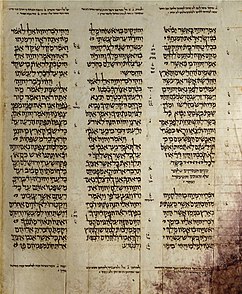Jeremiah 19 is the nineteenth chapter of the Book of Jeremiah in the Hebrew Bible or the Old Testament of the Christian Bible. This book contains prophecies attributed the prophet Jeremiah, and is one of the Books of the Prophets.
| Jeremiah 19 | |
|---|---|
 A high resolution scan of the Aleppo Codex showing the Book of Jeremiah (the sixth book in Nevi'im). | |
| Book | Book of Jeremiah |
| Hebrew Bible part | Nevi'im |
| Order in the Hebrew part | 6 |
| Category | Latter Prophets |
| Christian Bible part | Old Testament |
| Order in the Christian part | 24 |
Text
editThe original text was written in Hebrew language. This chapter is divided into 15 verses.
Textual witnesses
editSome early manuscripts containing the text of this chapter in Hebrew are of the Masoretic Text tradition, which includes the Codex Cairensis (895), the Petersburg Codex of the Prophets (916), Aleppo Codex (10th century), Codex Leningradensis (1008).[1] Some fragments containing parts of this chapter were found among the Dead Sea Scrolls, i.e., 4QJera (4Q70; 225-175 BCE[2][3]) with the extant verse 1,[4] and 4QJerc (4Q72; 1st century BC)[5] with extant verses 8-9 (similar to Masoretic Text).[6][7][8]
There is also a translation into Koine Greek known as the Septuagint, made in the last few centuries BCE. Extant ancient manuscripts of the Septuagint version include Codex Vaticanus (B; B; 4th century), Codex Sinaiticus (S; BHK: S; 4th century), Codex Alexandrinus (A; A; 5th century) and Codex Marchalianus (Q; Q; 6th century).[9]
Parashot
editThe parashah sections listed here are based on the Aleppo Codex.[10] Jeremiah 19 is a part of the Seventh prophecy (Jeremiah 18-20) in the section of Prophecies of Destruction (Jeremiah 1-25). {P}: open parashah; {S}: closed parashah.
- {S} 19:1-5 {P} 19:6-13 {P} 19:14 {S} 19:15 [20:1-3 {S}]
Verse 1
edit- Thus says the Lord: "Go and get a potter’s earthen flask, and take some of the elders of the people and some of the elders of the priests."[11]
- "Take some of the elders of the people and some of the elders of the priests": In the King James Version: take of the ancients of the people, and of the ancients of the priests,[12] in the Septuagint, "take some of the elders of the people, and [some] of the priests" (Greek: ἀπὸ τῶν πρεσβυτέρων τοῦ λαοῦ καὶ ἀπὸ τῶν ἱερέων).[13]
Verse 2
edit- And go out to the Valley of the Son of Hinnom, which is by the entry of the Potsherd Gate; and proclaim there the words that I will tell you,[14]
- Cross references: Jeremiah 7:31, 19:6
- "The valley of the Son of Hinnom": from Hebrew: גיא בן הנם, gê ḇen-hin-nōm,[15] located very near to Jerusalem, of which a certain Hinnom was owner in Joshua's time (Joshua 15:8; 18:16), later is known as "Ge-hinnom" ("the valley of Hinnom"), that became the Greek word Gehenna, used by Jesus in Matthew 5:22.[16] The site was 'the scene of the most hateful form of idolatry' (Jeremiah 7:31), perhaps also connected locally with the potter's field. (cf. Matthew 27:7).[17]
Verse 6
edit- Therefore, behold, the days come, saith the LORD, that this place shall no more be called Tophet, nor The valley of the son of Hinnom, but The valley of slaughter.[18]
- Cross references: Joshua 15:8; 18:16; Jeremiah 7:31, 19:2
Using the setting of the valley, Jeremiah prophecies the people's horrible future that make them "resort to cannibalism", as one of the "curses for covenant violation" (Leviticus 26:29; Deuteronomy 28:53).[19]
See also
editReferences
edit- ^ Würthwein 1995, pp. 35–37.
- ^ Cross, F.M. apud Freedman, D.N.; Mathews, K.A. (1985). The Paleo-Hebrew Leviticus Scroll (11QpaleoLev). Winona Lake, Indiana. p. 55
- ^ Sweeney, Marvin A. (2010). Form and Intertextuality in Prophetic and Apocalyptic Literature. Forschungen zum Alten Testament. Vol. 45 (reprint ed.). Wipf and Stock Publishers. p. 66. ISBN 9781608994182. ISSN 0940-4155.
- ^ Fitzmyer 2008, p. 37.
- ^ "The Evolution of a Theory of the Local Texts" in Cross, F.M.; Talmon, S. (eds) (1975) Qumran and the History of Biblical Text (Cambridge, MA - London). p.308 n. 8
- ^ Tov, Emanuel (1989). "The Jeremiah Scrolls from Qumran". Revue de Qumrân. 14 (2 (54)). Editions Gabalda: 189–206. ISSN 0035-1725. JSTOR 24608791.
- ^ Fitzmyer 2008, p. 38.
- ^ Ulrich 2010, p. 568.
- ^ Würthwein 1995, pp. 73–74.
- ^ As reflected in the Jewish Publication Society's 1917 edition of the Hebrew Bible in English.
- ^ Jeremiah 19:1 NKJV
- ^ Jeremiah 19:1 KJV
- ^ "Jeremiah 19 Swete's Septuagint". biblehub.com.
- ^ Jeremiah 19:2 NKJV
- ^ Hebrew Text Analysis: Jeremiah 19:2. Biblehub
- ^ Poole, Matthew, A Commentary on the Holy Bible. "Jeremiah 19", accessed on 22 August 2019.
- ^ Ellicott, C. J. (Ed.) 1905). Ellicott's Bible Commentary for English Readers. Jeremiah 19. London : Cassell and Company, Limited, [1905-1906] Online version: (OCoLC) 929526708. Accessed 28 April 2019.
- ^ Jeremiah 19:6 KJV
- ^ Coogan 2007, pp. 1108-1109 Hebrew Bible.
Sources
edit- Coogan, Michael David (2007). Coogan, Michael David; Brettler, Marc Zvi; Newsom, Carol Ann; Perkins, Pheme (eds.). The New Oxford Annotated Bible with the Apocryphal/Deuterocanonical Books: New Revised Standard Version, Issue 48 (Augmented 3rd ed.). Oxford University Press. ISBN 9780195288810.
- Fitzmyer, Joseph A. (2008). A Guide to the Dead Sea Scrolls and Related Literature. Grand Rapids, MI: William B. Eerdmans Publishing Company. ISBN 9780802862419. Retrieved February 15, 2019.
- Ulrich, Eugene, ed. (2010). The Biblical Qumran Scrolls: Transcriptions and Textual Variants. Brill.
- Würthwein, Ernst (1995). The Text of the Old Testament. Translated by Rhodes, Erroll F. Grand Rapids, MI: Wm. B. Eerdmans. ISBN 978-0-8028-0788-5. Retrieved January 26, 2019.